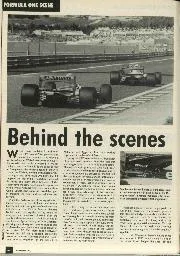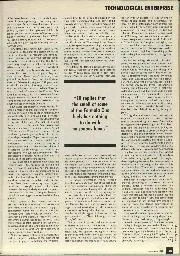

Behind the scenes
We all know that Nigel Mansell won the 1992 World Championship and some of us know that he drove a Williams-Renault FW14B in order to achieve it. Those who are…
Historic Grand Prix Cars
ACCORDING to Luigi his, the Alta Romeo historian, the Milanese firm built six of their famous Tip() B monopostos in 1932, with spares for three more. In 1934, he says, they built seven new cars to the 1934-37 Formula, with wider bodywork, and spares for four more. This suggests that the factory actually built thirteen Tipo B monopostos and could conceivably have built seven more, though it is more likely that the spares got used up repairing the ravages of Grand Prix racing. Enzo Ferrari was running the Alfa Romeo team in those days, soul! she monopostos went through thc hands of the Scuderia Ferrari and, after serving their useful life as team cars they were sold off. It wc accept Fusi’s figures then there should not be more than twenty monopostos in existence at the very most. At the moment we know of the existence of thirteen, not all complete and running, but verifiable as original minwposto Alfa Romeos.
The first batch of cars were numbered 5001 to 5006 and the second batch 50001 to 50007, that extra in the 1934 series often causing a lot of confusion. The 1932 cars began with 2.65-litre engines and 4-speed gearboxes, later to be enlarged to 2.9-litres with 3-speed gearboxes, and the 1934 cars all started as 2.9-litres and some of them were enlarged to 3.2-litres. In general terms the cars were referred to as “two-nine Alfas” but more seriously they were called “mortoposw” (single-seater) as they were Alfa Romeo’s first truly narrow single-seater, the previous racing cars from Portcllo either being two-seaters, like the P2 and the Manua, or wide single-seaters like the Tipo A. When the Tipo B first appeared there were no body measurement limits so it really was a slim “singlc-seater” but the 1934 Grand Prix Formula called for a minimum body width of 85 cm. so the sides of the cockpit were bulged out beyond the width of the chassis rails. All the cars used Vittorio Jano’s straight-eight-cylinder engine, with twin overhead camshafts and twin superchargers on the near side and the exhaust system on the right, the reverse layout 55 the previous straight-eights as used in the Monza and the 8C. Unique to the Tipo B was the transmission which was divided into a Y-shapc behind the gearbox, with a propeller-shaft in a torque-tube running rearwards and outwards to each rear wheel, each side having its own small orownwheel and pinion. Thc differential was incorporated in the gear drive on the rear of the gearbox where the drive split. The rear axle casing was conventional in that it was mounted on the rear semi-elliptic leaf springs, but the centre section joining the two bevel gear housings was empty. This split PmPshaft system had been tried by Juno on the Tipo A, which had two six-tylinder engines side-by-sidc and tvvo gearboxes! In 1935 Ferrari modified the previous year’s cars, fitting some with reversed quarter-elliptic rear springs, like a Bugatti, and some with independent front suspension on the pubonnet principle. The car we are concerned with this month is a straightforward 1934 Tipo B ,wwwPorro that was sold to R. 0. (Dick) Shuttleworth at the beginning of the 1935 season.